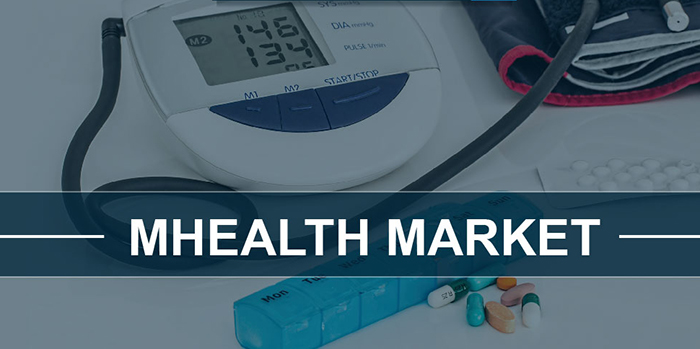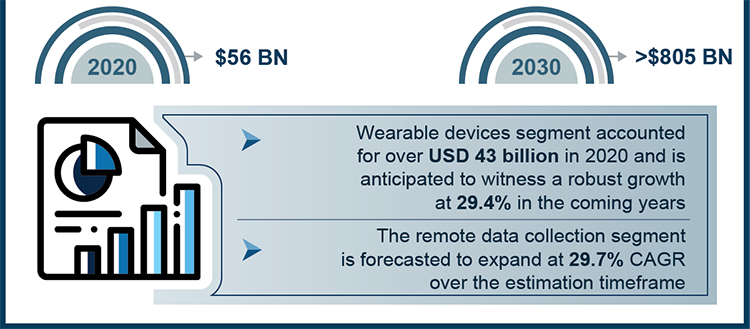Fast-Growing mHealth Industry Reinforces Healthcare Digitalization

The global mHealth industry is becoming one of the fastest-growing areas for investment. Increased use of mobile devices, demand for mobile-first approaches in healthcare service delivery, intensifying pace of innovation, and the boom in digital health since COVID-19 outbreak are identified are some of the primary factors driving the digital healthcare trends.
The demand for mHealth technology is driven by both consumers and healthcare providers. Consumers are now increasingly conscious about their health and healthcare professionals are seeking new solutions that they can rely on. There is a demand for more accessible, reliable, user-friendly and focus-oriented mHealth solutions that can enhance experience across both the domains.

Mobile Apps Enhance mHealth Delivery
mHealth apps continue to grow in prominence as consumers seek more individualized control over the way healthcare is accessed. From the ability to book, change, and cancel appointments to gaining easy access to electronic health records and e-consultation, users who have downloaded mobile health applications have benefitted significantly. As mobile and handheld devices become more prevalent and technologically advanced, innovations in mHealth app development are gaining speed.
Evidently, mHealth industry is seeing a steady rise in the adoption of wellness management apps. These include apps that help consumers with diet & nutrition, exercise & fitness, lifestyle & stress, and others. The Samsung Health (S Health) app, for example, allows users to manage health better and stay motivated while tracking nutrition, sleep, fitness, weight loss, and other parameters.
Swiss diet and lifestyle coaching app Oviva is another excellent example in the wellness management category. Recently in September 2021, Oviva raised $80 million in a funding round to expand its reach in the U.K., Switzerland, Germany, and France.
Health condition management is a key segment of the mHealth market which is increasingly gaining traction. The category includes disease specific apps, medication reminders, focus on women health, and other segments. The use of these apps is on the rise as they can be cost-effective, convenient, and easy-to-use.
Recently, several apps for health condition management have been introduced in the market:
- The Mount Sinai Health System launched a new mobile app in August to improve care for patients with risk of heart attacks. The platform enhances communication among doctors and healthcare staff so that patients can receive faster and more focused care.
- In April, French start-up Nabla had rolled out a new app focused on women’s health. The apps offers users the ability to connect with health professionals including general practitioners, gynecologists, nurses, midwives, nutritionists, or physiotherapists.
The widespread penetration of mobile devices and 5G access will continue boost the adoption of mHealth apps in the future. With consistent efforts by developers, these apps will only get better, more efficient, more accurate, and more reliable.
Inevitable Role of Wearables in mHealth
mHealth platforms are often closely connected with smart wearables, since the majority of wearable devices operate through or with a mobile app. Wearables are largely popular for fitness and exercise, sleep tracking, and weight management applications. However, of late, their use in other areas has been expanding, creating promising opportunities for the mHealth industry.
Merck collaborated with digital health firm Evidation Health to launch a new remote patient monitoring program for people with Alzheimer’s Disease. The companies plan to use smartphones and mHealth wearables to track the daily routines of elderly patients with and without cognitive impairment.
The application of wearables is not only limited to this. A study recently published in the Journal of the American Medical Association (JAMA) revealed that the use of mHealth wearables such as smartwatches can significantly enhance healthcare access for patients with atrial fibrillation (AF).
Wearable-based mHealth services are also playing a critical role in helping to curb the spread of the novel COVID-19 pandemic. In May, for example, Intermountain Healthcare Utah, the Rush University Medical Center in Chicago, and the University of Texas Health Science Center at Houston had partnered for a federally funded project to develop an mHealth app that can continuously track COVID-19 patients at home.
While physicians and patients remain the major end-users of wearables, the mHealth market is witnessing tremendous growth opportunities across the government sector. Government bodies are actively investing in mHealth wearables for health and wellness management. Earlier in May, for instance, the U.S. Army Medical Research and Development Command (USAMRDC) had issued a $2 million grant to New York-based developer Oculogica to design an mHealth wearable that can identify concussions.
Wearable devices have evolved significantly since their inception to become more powerful and offer better functionality. Imaging, proximity and biosensor technologies are advancing at a monumental pace, which can take the application of wearable tech in mobile health to a whole new level. mHealth wearables will certainly transform the way how digital care is delivered to patients across emerging economies.
As mHealth adoption surges, mobile apps, wearables and connected medical devices are rapidly becoming part of mainstream healthcare. They are being increasingly used to empower patients and play a more proactive role in health management. For providers, mHealth offers the ability to make more data-driven diagnostic decisions, enabling better patient care.